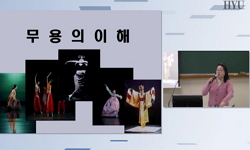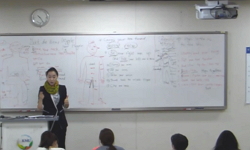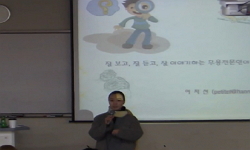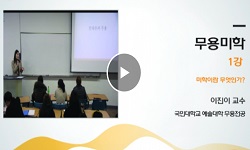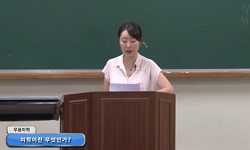中國 朝鮮族舞踊의 價値와 認識은 傳統舞踊의 繼承과 變形的 發展에 있다고 하겠다. 이 硏究는 朝鮮族무용의 歷史的 變遷過程에서 만들어진 基本動作 構造分析을 통해 시간, 공간, 움직임...
http://chineseinput.net/에서 pinyin(병음)방식으로 중국어를 변환할 수 있습니다.
변환된 중국어를 복사하여 사용하시면 됩니다.
- 中文 을 입력하시려면 zhongwen을 입력하시고 space를누르시면됩니다.
- 北京 을 입력하시려면 beijing을 입력하시고 space를 누르시면 됩니다.
延邊 朝鮮族舞踊의 變遷過程과 基本動作 構造硏究 : 上體動作을 中心으로 = (The) Study on the Process of Change and Basic Movement Structures of Chinese-Korean Dances
한글로보기https://www.riss.kr/link?id=T9284948
- 저자
-
발행사항
용인 : 명지대학교 대학원, 2003
- 학위논문사항
-
발행연도
2003
-
작성언어
한국어
- 주제어
-
KDC
685.1 판사항(4)
-
DDC
796 판사항(20)
-
발행국(도시)
경기도
-
형태사항
viii, 114p. : 삽도 ; 26cm
-
일반주기명
참고문헌: p. 106-109
- 소장기관
-
0
상세조회 -
0
다운로드
부가정보
국문 초록 (Abstract)
中國 朝鮮族舞踊의 價値와 認識은 傳統舞踊의 繼承과 變形的 發展에 있다고 하겠다. 이 硏究는 朝鮮族무용의 歷史的 變遷過程에서 만들어진 基本動作 構造分析을 통해 시간, 공간, 움직임의 特性을 分析하는데 目的이 있다.
限界점으로는 朝鮮族舞踊基本動作에서 種類別 動作들을 그 數에 있어 制限한 것이며, 提案된 動作을 可能한 한 單純化 시키려함에 따라 제자리에서의 움직임으로만 한 것이다.
시대적 변천에 따라 조선족 무용의 발전과정을 알아보았다. 그 결과, 조선족 무용은 민족의 전통에 바탕을 두었으나, 역사적 조건과 서로 다른 환경, 이념의 차이 등으로 전위되고, 변화되어 왔음을 알 수 있었다.
朝鮮族舞踊의 上體의 基本動作을 分析한 結果에 따르면 모든 움직임들은 서로 聯關性을 形成하며, 동작 속에 內在的으로 또는 現象的으로 存在하는데 그 움직임들이 결코 따로 일어나는 것이 아니라 서로 融合의 一體가 되어 形態가 이루어지고 또 다른 形態의 움직임으로 變할 때마다 內的인 마음까지 同參하는 特徵을 가지고 있는 것으로 나타났다. 또한 民族的인 線과 中國의 形態 中心적인 우월성을 수용하여 線의 흐름이 있으면서도 動作의 形態美가 있는 調和로운 움직임이 特徵的이며, 늦은 速度보다 빠른 速度, 좁은 공간보다 넓은 공간의 變形이 相對的으로 많이 나타났으며 自由自制로 形象表出을 할 수 있는 能力을 갖추게 하는 것으로 나타났다.
따라서, 이 硏究는 速繫學文 속에서 특히 敎育의 도구로서, 안무가의 自由奔放한 움직임, 接舞의 基本的인 資料로서 그 價値를 지닐 것이라 할 수 있겠다.
다국어 초록 (Multilingual Abstract)
The value of( the Korean-Chinese dance lies in its succession and transformational development of the traditional Korean dance, and it should be recognized as such. The purpose of this study is to present a specialized training system by analyzing the...
The value of( the Korean-Chinese dance lies in its succession and transformational development of the traditional Korean dance, and it should be recognized as such. The purpose of this study is to present a specialized training system by analyzing the structure of basic movements. The analysis compares two approaches to analyzing the qualities of movements structural and qualitative approaches. The movements, in turn, are analyzed in terms of time, space, qualities, and expressive features.
This study is focused on the limited number of basic movements found in the dance tradition of the Korean Chinese. In addition, the movements are restricted to those engaged while standing still as this study tries to simplify the proposed movements as further as possible.
The analyses gets to the conclusion that the basic movements, which display extended time of relaxation and contraction, can express all the human emotions of joy, anger, love, and pleasure with their multiple forms. Also, the movements can contribute significantly to making the body fit (or dancers, and the result would be a balanced body ideal for dancers.
Each movement is interlinked and exists in an inherently balanced sum of parts, not in parts themselves. They come together as a whole and assume a harmonious form. When one form changes into another, the mind also goes through a change. These qualities of movements, supported by time and rhythm, form into a unique charm of movements. Aside from these qualities, the baslc movements of the Korean Chinese dance are also characteristic of their extensive width and intensive technicality. They are fast and display a number of varieties. Based on this, this study supports the case for developing a systematic training of basic movements that will help dancers to develop highly sophisticated skills and agile muscles.
If the mission of the Korean traditional dance in the 21st century is to develop all forms of dance into the level of arts and to study the aesthetic values of the dance as an art, then the focus should be on developing a training system and designing basic movements that can help dancers to develop a body that can express any form of shape. These would have significant value not only as an educational tool but also as reference sources for choreography and dancing expressive of free spirit.
목차 (Table of Contents)
- 목차 = ⅳ
- Ⅰ. 序論 = 1
- 1. 硏究의 必姿性 및 目的 = 1
- 2. 硏究問題 = 4
- 3. 硏究方法 = 5
- 목차 = ⅳ
- Ⅰ. 序論 = 1
- 1. 硏究의 必姿性 및 目的 = 1
- 2. 硏究問題 = 4
- 3. 硏究方法 = 5
- 4. 硏究의 制限點 = 5
- 5. 用語의 定議 = 6
- Ⅱ. 朝鮮族舞踊의 變遷過程 = 8
- 1. 延邊朝鮮族舞踊의 形成時期(이주시기~解放前 : 1949年) = 8
- 2. 새로운 舞踊의 發展時期(解放後 : 1949年~1966年) = 28
- 3. 延邊朝鮮族 舞踊의 混亂時期(文化大革命 : 1966年~1976年) = 35
- 4. 朝鮮族舞誦의 復興時期(文化大革命 以後 : 1976年~1990年代) = 37
- Ⅲ. 朝鮮族舞踊 基本動作 構造分析 = 43
- 1. 朝鮮族舞踊 基本動作形成 = 43
- 2. 基本動作構造 = 47
- 3. 上體의 基本動作構造 = 50
- Ⅳ. 朝鮮族舞踊基本動作의 總體的分析 = 93
- 1. 時間的 特性 = 94
- 2. 空間的 特性 = 95
- 3. 움직임의 質的 特性 = 96
- 4. 表現的 特性 = 97
- Ⅴ. 結論 및 提言 = 100
- 참고문헌 = 106
- Abstract = 110
- 부록 = 112





